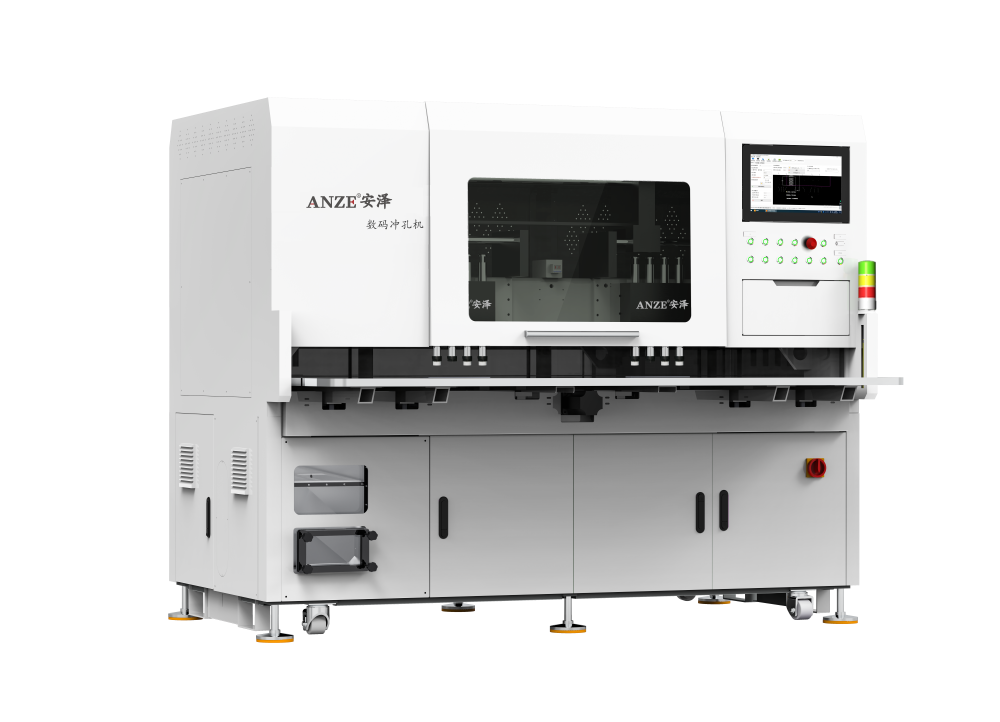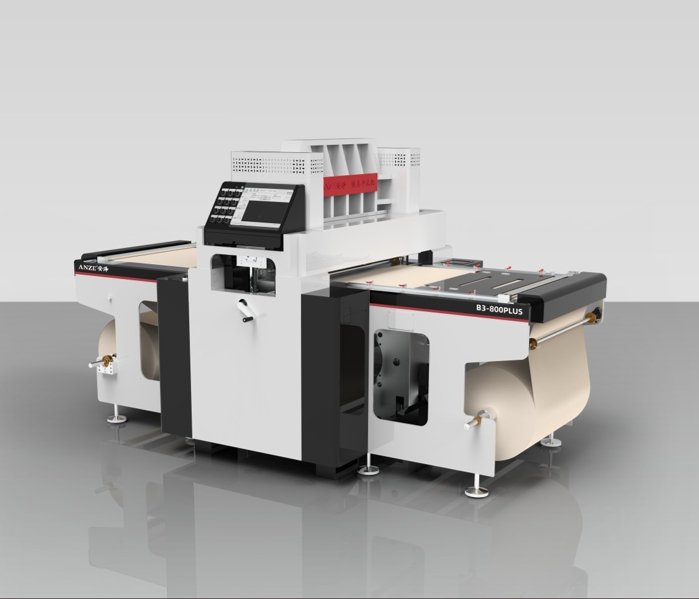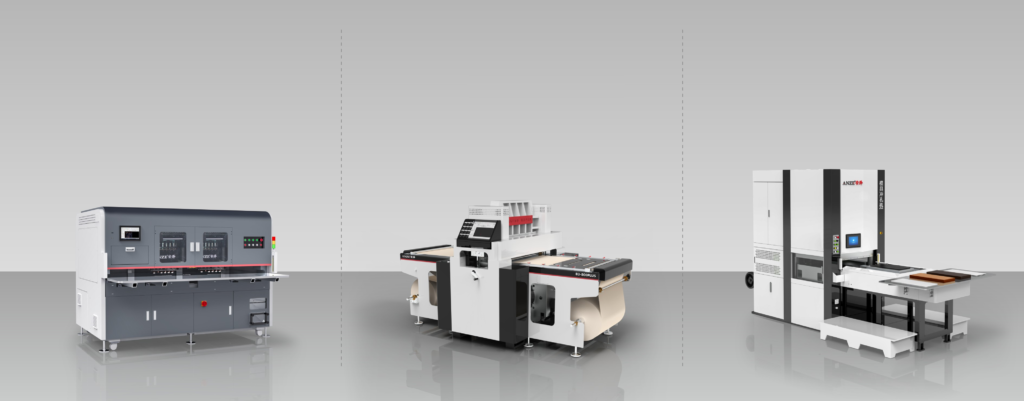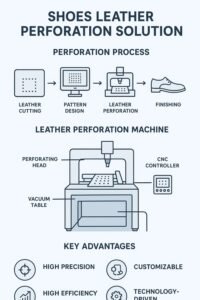Last Updated on 2025-05-21 by Anze
As a key equipment in the leather processing industry, the technological development and application of leather punching machine is of great significance to improving production efficiency, processing quality and meeting diversified market demands. This article systematically sorts out the working principle, key technologies and type characteristics of leather punching machines, and deeply discusses its design principles, manufacturing processes and quality control methods in the design and manufacturing process. The study pointed out that with the continuous integration of CNC technology, electronic technology and software technology, leather punching machines have gradually achieved high-precision, high-speed and automated production, bringing revolutionary changes to the leather processing industry.
In terms of application fields, leather punching machine is not only widely used in traditional leather processing fields such as auto parts, luggage and handbags, stationery, and footwear, but also gradually expanded to emerging fields such as advertising paper products, textile industry, and construction industry. Through the analysis of specific practical cases, this article demonstrates the significant effects of leather punching machines in improving production efficiency, reducing production costs, and enhancing product market competitiveness. At the same time, this article also looks forward to the future development trends of leather punching machine technology, including intelligent, networked and green directions, which provides strong support for the sustainable development of the leather processing industry.
1-introduction
1.1 Research background of leather punching machine
Leather punching machine, as a key equipment in the field of leather processing, is widely used and its importance is becoming increasingly important. Leather punching machines play an indispensable role in many industries such as auto parts, bags and bags, stationery, footwear, and advertising paper products. It uses a high-speed rotating punch to precisely punch holes in leather and other materials. This process not only greatly improves production efficiency, but also significantly enhances the diversity and aesthetics of products, satisfying the market and consumers’ needs for product personalization and Differentiated needs.
With the continuous advancement of science and technology, the technology of leather punching machines is also continuing to develop and innovate. From the initial manual operation to today’s automated and intelligent control, the performance of leather punching machines has been greatly improved. For example, modern leather punching machines are equipped with advanced CNC systems, which can achieve precise positioning, efficient punching, and have functions such as automatic feeding and automatic adjustment, which greatly reduce the difficulty of operation and labor intensity.
The diversification of consumer demands has also promoted the continuous innovation of leather punching machine technology. Today, the market’s demand for leather products is no longer limited to traditional practicality and durability, but pays more attention to the fashion, personalization and environmental protection of products. Therefore, leather punching machines have also made many improvements and innovations in the punching process, such as the use of advanced technologies such as laser punching and ultrasonic punching, which not only improve the punching accuracy and efficiency, but also enrich the styles and styles of leather products .
The technological development and application prospects of leather punching machines are very broad. With the continuous emergence of new materials, new processes and the in-depth application of intelligent manufacturing technology, leather punching machines will achieve more technological breakthroughs and innovations in the future. At the same time, as the global leather market continues to expand and consumer demand for high-quality leather products continues to grow, the application fields of leather punching machines will also be further expanded and deepened.
As an important equipment in the leather processing industry, the technological development and application of leather punching machines is of great significance to improving the production efficiency, quality and market competitiveness of leather products. In the future, with the continuous advancement of technology and changing market demand, leather punching machines will usher in more development opportunities and challenges. Therefore, we need to pay close attention to the technical dynamics and market trends of leather punching machines to promote them to better serve the leather processing industry and meet the diverse needs of consumers.
1.2 The research significance of leather punching machine
In-depth exploration of the technological development and application of leather punching machines is of great significance for improving production efficiency and processing quality. The role of this kind of special equipment in the leather processing industry has become increasingly prominent, especially its application in many subdivided fields such as auto parts, luggage and handbags, stationery, footwear, and advertising paper products, which has promoted the continuous innovation and development of its technology. develop.
From the perspective of production efficiency, an efficient leather punching machine can significantly shorten the production cycle. The traditional leather punching process mostly adopts manual or semi-automatic methods, which is not only inefficient but also high in labor costs. Modern leather punching machines can complete a large number of precise punching tasks in a short time through high-speed rotating punches, thus greatly improving production efficiency. This improvement in efficiency means that companies can deliver more products in a shorter period of time, thereby occupying a favorable position in market competition. At the same time, reducing labor costs is also one of the goals pursued by enterprises. The higher the degree of automation of the leather punching machine, the less dependent it is on labor, and the company’s investment in human resources will be reduced accordingly, which will help improve the overall economic benefits of the company.
In terms of processing quality, advanced punching technology ensures the accuracy and consistency of punching. Leather is a natural material and may vary in surface texture and thickness. Therefore, during the drilling process, how to ensure that the size, shape and position of each hole meets the design requirements is a very challenging issue. By using advanced control systems and precision machining technology, leather punching machines can achieve precise punching of leather to meet high-standard production needs. This high-precision processing not only improves the overall quality of the product, but also wins the company a good market reputation.
The diversified punching pattern and hole shape design capabilities of the leather punching machine are also an important manifestation of its research significance. As consumer demands become increasingly diverse, a single product style can no longer meet market demand. The leather punching machine can easily process various complex patterns and hole shapes by replacing different punches and dies. This diversified design capability not only enhances the aesthetics and fashion of the product, but also enhances the added value and market competitiveness of the product. For consumers who pursue personalization and differentiation, this diversified product selection is undoubtedly more attractive.
The significance of the research on leather punching machine lies in their ability to significantly improve production efficiency and processing quality while meeting the diversified needs of the market. With the continuous advancement of science and technology and the continuous upgrading of consumer demand, the technological development and application prospects of leather punching machines will be broader. In the future, leather punching machines are expected to exert their unique advantages in more fields and bring revolutionary changes to the leather processing industry.
1.3 Current research status at global
In the field of leather punching machine technology, both at home and abroad, significant research progress and application results have been achieved. These progress are not only reflected in the performance improvement and function expansion of the punching machine, but also in the innovation of related technologies and the deepening of market applications.
Abroad, many well-known companies have made important breakthroughs in key technologies such as high precision, high speed and automation of leather punching machines. For example, by adopting advanced CNC systems and precision mechanical components, foreign punching machines can achieve micron-level punching accuracy and hundreds of punching speeds per second. This high-performance punching machine is widely used in the processing of high-end leather products, such as luxury brand bags and high-end car seats. At the same time, foreign companies also pay attention to the automation and intelligent development of punching machines, and realize automatic monitoring and adjustment of the punching process through integrated sensors, visual recognition and other technologies, further improving production efficiency and processing quality.
Domestically, although it started late, it has also made great progress in leather punching machine technology in recent years. Domestic companies give full play to their latecomer advantages, and continuously improve the cost-effectiveness and customized service capabilities of punching machines through technology introduction, digestion and absorption, and re-innovation. For example, the economical leather punching machines launched by some domestic enterprises have greatly reduced the equipment cost while maintaining high performance, allowing more small and medium-sized enterprises to enjoy the dividends brought by advanced technology. In addition, domestic enterprises have also developed a variety of special punching machines with independent intellectual property rights for specific industries and user needs, such as multi-functional combination punching machines, intelligent CNC punching machines, etc., to meet the diversified needs of the market.
In the process of narrowing the gap with the international advanced level, domestic enterprises not only focus on technological innovation, but also strengthen cooperation and exchanges with foreign counterparts. By participating in international exhibitions, technical seminars and other activities, domestic enterprises have timely learned about the latest international dynamics and technological trends, providing strong support for their own research and development and innovation. At the same time, domestic enterprises are also actively introducing foreign advanced technologies and talents, and continuously improving their core competitiveness through digestion, absorption and re-innovation.
With the continuous advancement of science and technology and the continuous changes in market demand, leather punching machine technology will face more development opportunities and challenges. Domestic and foreign enterprises should continue to increase R&D investment and innovation efforts to promote leather punching machine technology to develop in the direction of higher precision, higher speed, more automation and more intelligence. At the same time, enterprises should also pay close attention to market dynamics and changes in user needs, and adjust product structure and market strategy in a timely manner to meet the diversified and personalized needs of the market. In this process, strengthening international cooperation and exchanges will still be one of the important ways to promote the development of leather punching machine technology.

2-Leather punching machine technology basics
2.1 Working principle of leather punching machine
The working principle of the leather punching machine is to drive the crankshaft to rotate through the motor, and further drive the punch to perform the punching operation in the up and down reciprocating motion. In this process, the shape and size of the punch are not fixed, but can be adjusted according to actual needs to adapt to the requirements of different materials and hole types. This flexibility makes the leather punching machine more adaptable and diverse during the processing.
In addition to the basic punching function, the leather punching machine is also equipped with a series of auxiliary devices, such as automatic feeding devices, positioning devices and discharge devices. The existence of these auxiliary devices greatly improves production efficiency and punching accuracy. For example, the automatic feeding device can ensure the continuous supply of leather materials during the processing process, reducing the pauses and errors caused by manual operation; the positioning device can ensure that the punch can accurately align with the predetermined position every time it punches, thereby ensuring the consistency and accuracy of the punching; and the discharge device can discharge the processed leather materials in time to prepare for the next round of processing.
In the working process of the leather punching machine, the choice of motor is also crucial. The performance of the motor directly affects the operating stability and punching efficiency of the punching machine. Therefore, when purchasing a leather punching machine, it is necessary to carefully examine and compare the performance of the motor to ensure that you purchase a punching machine with excellent performance, stability and reliability.
Leather punching machines also need to pay attention to maintenance and care during use. Regular inspection, cleaning and lubrication of the punching machine can extend the service life of the equipment and improve the operating efficiency of the equipment. At the same time, for the faults and problems that occur, it is also necessary to promptly investigate and repair them to avoid production stoppages and losses caused by equipment failure.
The working principle of the leather punching machine is simple and efficient. Through the cooperation of motor drive and auxiliary devices, efficient and accurate punching of leather materials is achieved. This equipment has a wide range of application prospects in the leather processing industry and is of great significance for improving production efficiency and processing quality.
With the continuous advancement of science and technology, the technology of leather punching machines is also constantly innovating and developing. In the future, we can look forward to the emergence of more intelligent and automated leather punching machine equipment, which will bring a more convenient and efficient processing experience to the leather processing industry. At the same time, with the increasing diversification of consumer demand, leather punching machines will also play a more important role in personalized and customized processing to meet the market’s demand for diversified and high-quality leather products.
2.2 Overview of key technologies
The key technologies of leather punching machines cover many aspects, among which the control system, transmission system and mold technology are particularly critical. The synergy of these technologies ensures the accuracy, efficiency and stability of the punching machine during the punching process.
As the “brain” of the leather punching machine, the control system plays a vital role. The system uses advanced algorithms and precise sensors to monitor and adjust the motion state of the punch in real time, including key parameters such as its motion trajectory, speed and strength. This fine control not only ensures the accuracy of the punching, but also enables the punching machine to adapt to changes in different materials and processing requirements. In practical applications, the performance of the control system often directly affects the overall performance and production efficiency of the punching machine.
The transmission system is the “skeleton” and “muscle” of the leather punching machine, responsible for efficiently and stably transmitting the power generated by the motor to the punch. In this process, the transmission system needs to ensure that the punch can move at high speed and reciprocate according to the predetermined trajectory while maintaining sufficient stability and durability. To achieve this goal, the transmission system usually uses precise mechanical structures and high-quality materials to ensure its reliability and performance under long-term and high-intensity work.
Mold technology is the key factor in determining the shape and size of the punching. The design and manufacture of molds need to fully consider the actual needs of the product and the production process to ensure that the punched holes can meet the design requirements and have good consistency and aesthetics. At the same time, the durability and maintainability of the mold are also important indicators for evaluating its performance. In practical applications, high-quality molds can not only improve production efficiency, but also reduce production costs and maintenance costs.
Control system, transmission system and mold technology are the three key technologies in leather punching machines. The continuous development and innovation of these technologies have promoted the improvement of the overall performance of leather punching machines and the expansion of their application fields. In the future, with the advancement of science and technology and the continuous changes in market demand, these key technologies will continue to play an important role and promote the leather punching machine industry to a higher level.
2.3 Types and characteristics of leather punching machines
Leather punching machines, as indispensable equipment in the leather processing industry, can be mainly divided into two categories according to their technical characteristics and application requirements: mechanical leather punching machines and CNC leather punching machines. In addition, there are some special types of small leather punching machines to meet the needs of specific fields and scenarios.
Mechanical leather punching machines are known for their relatively simple structure and convenient operation. This type of punching machine is usually suitable for punching large areas of leather and can efficiently complete the punching task. In a mechanical punching machine, the motor drives the crankshaft to rotate, which in turn drives the punch to reciprocate up and down to achieve the punching operation. Due to the structural characteristics of the mechanical punching machine, its maintenance cost is relatively low, and it shows good stability during the production process.
CNC leather punching machines represent the advanced level of punching technology. This type of punching machine integrates CNC technology, electronic technology and software technology, making the punching operation more accurate and flexible. CNC leather punching machines can realize automatic typesetting, automatic scanning and precise positioning of complex patterns, greatly improving production efficiency and product quality. In addition, CNC punching machines also have a high degree of automation, which can reduce the labor intensity of operators and improve the comfort of the production environment.
In addition to the two main types of leather punching machines mentioned above, there are also some special types of small leather punching machines on the market. These devices are usually designed for specific fields and scenarios, such as the punching needs of small leather products such as shoes, bags and handbags. Small leather punching machines have the characteristics of small size and portability. They can be used flexibly in different environments to meet diverse production needs.
There are various types of leather punching machines, each with its own characteristics. Mechanical leather punching machines are suitable for large-area leather processing with their simple structure and high efficiency; CNC leather punching machines rely on advanced technical support to achieve high-precision and high-flexibility punching operations; and small leather punching machines provide convenient solutions for specific needs. These different types of leather punching machines have jointly promoted the development and progress of the leather processing industry.
3-Design and manufacture of leather punching machine
3.1 Design principles and ideas
When designing a leather punching machine, its actual application scenarios and production needs must be fully considered to ensure that the equipment can operate stably and efficiently in various environments. To achieve this goal, designers need to follow a series of clear design principles and ideas.
The first principle is efficiency. In modern industrial production, time is money, so the design of the punching machine must focus on improving production efficiency. This can be achieved by optimizing the mechanical structure, increasing the punching speed, and reducing the die change time. For example, the use of advanced transmission systems and servo control technology can ensure the stability and accuracy of the punch in high-speed movement, thereby greatly improving the punching efficiency.
Stability is another indispensable design principle. The leather punching machine must maintain stable performance during long-term operation to ensure the quality of punching and equipment safety. To achieve this, designers need to perform precise calculations and rigorous tests on each component of the equipment to ensure its structural strength and durability. In addition, the use of high-quality materials and advanced manufacturing processes is also the key to improving the stability of the punching machine.
Ease of maintenance is also an important factor to be considered in the design process. Any equipment will inevitably fail or wear out during use, so the design of the punching machine must be easy to maintain and maintain. This means that the various parts of the equipment should be easy to disassemble and replace, and the maintenance process should be as simple and quick as possible. By adopting modular design and standardized parts, maintenance costs and downtime can be greatly reduced, thereby improving the overall efficiency of the equipment.
The design of a leather punching machine is a complex and meticulous process, requiring designers to fully consider multiple aspects such as production efficiency, stability and ease of maintenance. Only in this way can we create high-quality punching equipment that is both efficient, stable and easy to maintain, meeting the diverse needs of the modern leather processing industry.
3.2 Manufacturing process
In the manufacturing process and process of leather punching machine, every link is crucial, and they jointly ensure the quality and performance of the punching machine.
Material selection is the first link in the manufacturing process. In order to ensure the structural strength and durability of the punching machine, high-quality materials must be carefully selected. High-quality steel is widely used because of its excellent strength and toughness, and can effectively withstand various stresses in the punching process. At the same time, the selection of wear-resistant materials is also crucial. They can maintain stable performance in an environment of high-speed operation and frequent friction, thereby extending the service life of the punching machine.
The processing process is the core link in the manufacture of punching machines. At this stage, advanced processing equipment and exquisite process technology are used to shape various parts. Through precise cutting, grinding and heat treatment processes, the accuracy and consistency of parts are effectively guaranteed. This not only lays a solid foundation for subsequent assembly and debugging, but also provides reliable support for the efficient operation of the punching machine.
The assembly and debugging link is a comprehensive inspection of all the previous work. At this stage, the various parts are carefully assembled together to form a complete punching machine. Subsequently, through comprehensive inspection and testing, including evaluation of electrical performance, mechanical performance and safety performance, it is ensured that the performance indicators of the punching machine meet the design requirements. The rigor and meticulousness of this link have a decisive influence on ensuring the overall quality and use effect of the punching machine.
The continuous optimization of manufacturing processes and procedures is also the key to improving the competitiveness of leather punching machines. With the continuous advancement of science and technology and the continuous emergence of new materials and new processes, the manufacturing process of leather punching machines is also constantly innovating and developing. By continuously improving the process flow and introducing advanced manufacturing technology and equipment, the production efficiency of the punching machine can be further improved, costs can be reduced and product quality can be improved, so as to better meet market demand and customer expectations.
3.3 Quality Control and Testing
In the manufacturing process of leather punching machines, the importance of quality control and testing is self-evident. The implementation of this link is to ensure that every punching machine shipped can meet the predetermined performance indicators, so as to provide users with stable and reliable processing equipment.
Quality control runs through the entire manufacturing process. From the procurement of raw materials to the processing of parts and components, to the assembly and commissioning of the whole machine, each link has strict quality standards and control measures. For example, in the raw material procurement stage, manufacturers will strictly inspect key raw materials such as steel and wear-resistant materials to ensure that their quality meets the design requirements. During the processing, advanced processing equipment and exquisite craftsmanship are used to ensure the accuracy and interchangeability of parts. In addition, regular inter-process inspections and finished product sampling further ensure the stability and consistency of product quality.
The detection methods are also rich and diverse, covering mechanical performance testing, electrical safety testing, appearance quality inspection and other aspects. These tests not only focus on the static performance of the punching machine, but also evaluate its dynamic performance and service life. For example, the stability and durability of the punching machine can be tested by simulating long-term operation tests in actual working environments. At the same time, advanced testing equipment and professional testing teams provide strong guarantees for the accuracy and effectiveness of these tests.
In addition to quality control and testing during the manufacturing process, the acceptance of finished products is also crucial. In this link, manufacturers will conduct comprehensive and detailed inspections and tests on punching machines in accordance with relevant standards and contract requirements. Only those punching machines that pass the acceptance will be labeled as qualified and delivered to users. This strict finished product acceptance system not only improves the overall quality level of the product, but also enhances the user’s trust and satisfaction with the manufacturer.
Quality control and testing play a vital role in the manufacturing process of leather punching machines. By implementing strict quality control measures and diversified testing methods, manufacturers can ensure that every punching machine shipped has excellent performance and reliable quality. This not only improves the competitiveness of the punching machine in the market, but also brings users a more stable and efficient processing experience.
Some models are shipped assembled in the factory. Large equipment is packaged in several parts and an installation manual is provided. All equipment is equipped with user manuals in Chinese and English.
Customers can send someone to anze factory to learn or we send technical experts to provide on-site training
The machine should be fixed on a stable table and the environment should be kept clean and tidy to avoid contact with dust, static electricity, humidity, and chips to cause parts failure.
We have an experienced after-sales team 24h online service and a completafter-sale system. Factory trainning support, Video technical available to service machinery overseas. support, online support, Engineers.
Of course we do welcome to visiting our company and have a face-to-face communication to advance mutual business.
Lead time varies depending on the order quantity and customization, typically ranging from 7 to 10 working days.If it is a custom leather punching machine order, it takes 1-2 months.











